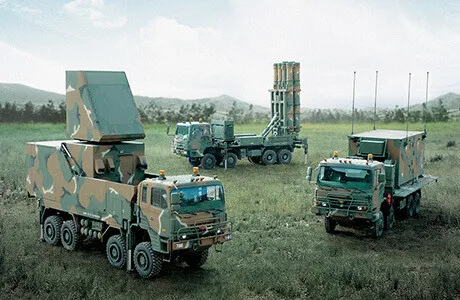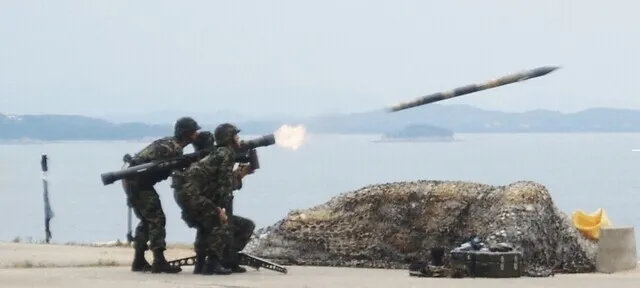hankyoreh
Links to other country sites 다른 나라 사이트 링크
Critics say supplying weapons to at-war Ukraine will lead to deployments of Korean logistics support

Criticism abounds with regard to the South Korean government’s announcement that it is looking into the possibility of sending lethal weapons to Ukraine. The criticism stems from the fact that providing lethal weapons to a country at war not only violates various domestic laws, but providing advanced weapons would lead to the deployment of personnel needed for the operation of such weapons. In this article, we examine the various weaknesses and strengths of the argument for sending weapons to Ukraine that is being made by Korea’s military and others.
South Korean President Yoon Suk-yeol said in a joint press conference after a summit with Polish President Andrzej Duda on Oct. 24 that while Seoul had maintained its principle of not directly supplying lethal weapons to Ukraine, his administration was open to “review[ing] our stance more flexibly, depending on the level of North Korean military activities.”
South Korea’s steadfast policy of denying Ukraine lethal weapons, which has been upheld since Russia invaded Ukraine in February 2022, has now been qualified as depending on the level of North Korean military activities. While this issue could heavily impact national security, no experts engaged in any debate on the topic, nor was the question opened to the public. As such, even more conservative-leaning media outlets have been critical of the government’s hasty policy change or calling for the merits of prudence in their editorial sections.
The biggest problem with providing lethal weapons to Ukraine lies in the fact that the country is currently engaged in a war. Many South Korean laws restrict the export of weapons in the name of international peace and the maintenance of safety and national security. The Defense Acquisition Program Act stipulates that domestic defense enterprises must inform the head of the Defense Acquisition Program Administration when they decide to engage in overseas exports and deals of weapons and receive authorization.
According to the act’s enforcement decree, the exportation of weapons may be restricted where “it is necessary for international peace, maintenance of safety and national security” and where “diplomatic friction is likely to occur as a result of exporting major defense materials and national defense science and technology.”
The provision of lethal weapons to Ukraine falls under these categories.
The article on the public notice of exportation and importation of strategic items, as part of the Foreign Trade Act, states that export permissions may be granted if the application is “in accordance with the guidelines prescribed by Presidential Decree for maintaining international peace and security, national security, etc.”
Weapons support to Ukraine, which is currently at war, would breach this general principle.
Some point out that the provision of weapons in Ukraine will inevitably lead to the deployment of South Koreans to the battlefield. This argument has to do with the characteristics of the weapons that Ukraine is asking the South Korean government to provide.
Ukraine is expected to request state-of-the-art air defense weapons such as surface-to-air missiles Shingung or Cheongung-II. In an interview with KBS on Sept. 30 (local time), Ukrainian President Volodymyr Zelenskyy stated that “what we need [from South Korea] is a defense system, particularly an air defense system.”
Cheongung-II, also dubbed the “Korean Patriot,” is a medium-range surface-to-air missile that can intercept jets and missiles at a range of 30-40 kilometers. The Cheongung-II does not merely include missiles but forms a complicated weapons system reliant on various equipment, parts, facilities and software.

The Cheongung-II system consists of missiles, launchers, engagement control centers, and multifunction radars. A single Cheongung-II battery has four launchers, 32 missiles, a multifunction radar and an engagement control center.
If Korea sends the Cheongung-II defense system to Ukraine, it is possible that South Korean soldiers experienced in its operation and technicians will provide follow-up logistics support by residing in Ukraine to educate locals on the operation and maintenance of the system.
While such military personnel would not be deployed on a large scale, nor would they be directly involved in actual combat, they would need to be armed for the sake of self-defense. If the war escalated, more soldiers would have to be deployed to protect these soldiers and technicians.
Concerns about vacuums in Korea’s own national security are also worth pointing out. The Cheongung-II is integral to the Korea Air and Missile Defense (KAMD) system as a safeguard against North Korean missile threats. With North Korea consistently making strides in advancing its nuclear and missile capabilities, the South Korean military cannot afford to surrender even one of its anti-ballistic missiles.
The lack of missiles in stock means that, if we were to provide Ukraine with this weapons system, we would be relinquishing an indispensable weapon needed by the South Korean military to ward off North Korean missiles.
While former Ukrainian Defense Minister Oleksii Reznikov asked then-South Korean Defense Minister Suh Wook for surface-to-air missiles support in a phone call on April 8, 2022, Suh refused, saying that “there are limits in providing such weapons given South Korea’s security situation.”
A former foreign security officer called for a reconsideration of the lethal weapons support policy by saying, “The South Korean military’s 155 mm artillery shell supply would only last a fortnight. As we are in such a precarious position, we are in no position to help others.”
By Kwon Hyuk-chul, staff reporter
Please direct questions or comments to [english@hani.co.kr]

Editorial・opinion
![[Column] Lee’s difficult task of striking a balance on Japan [Column] Lee’s difficult task of striking a balance on Japan](https://flexible.img.hani.co.kr/flexible/normal/500/300/imgdb/original/2025/0905/6317570584144597.jpg) [Column] Lee’s difficult task of striking a balance on Japan
[Column] Lee’s difficult task of striking a balance on Japan![[Editorial] Multipolar era means Seoul must broaden its diplomacy [Editorial] Multipolar era means Seoul must broaden its diplomacy](https://flexible.img.hani.co.kr/flexible/normal/500/300/imgdb/original/2025/0904/2017569747213826.jpg) [Editorial] Multipolar era means Seoul must broaden its diplomacy
[Editorial] Multipolar era means Seoul must broaden its diplomacy- [Column] North and South Korea are no longer pawns in US-China-Russia relations
- [Column] Who we fail when we oversimplify the ‘comfort women’ issue
- [Column] How Seoul can navigate its security in a shifting world order
- [Editorial] Former first lady’s indictment is consequence of her acting as though she were president
- [Correspondent’s column] A report card for the Lee-Ishiba summit
- [Editorial] America’s penchant for plundering allies
- [Editorial] Kim Jong-un’s return to diplomacy could be the start of a tectonic shift
- [Editorial] Lee clears first hurdle with Trump, but the race is not over yet
Most viewed articles
- 1Trump’s temperamental tariffs aren’t the win Americans think they are
- 2USFK sprayed defoliant from 1955 to 1995, new testimony suggests
- 3Real-life heroes of “A Taxi Driver” pass away without having reunited
- 4Former bodyguard’s dark tale of marriage to Samsung royalty
- 5“A bundle of blackened bones”: The search for unmarked graves of those killed in Gwangju Uprising
- 6[Editorial] Multipolar era means Seoul must broaden its diplomacy
- 7[Column] North and South Korea are no longer pawns in US-China-Russia relations
- 8Koreans are getting taller, but half of Korean men are now considered obese
- 9Records show how America stood back and watched as Gwangju was martyred for Korean democracy
- 1069% of Koreans use Galaxy phones, but majority of 20-somethings prefer iPhones